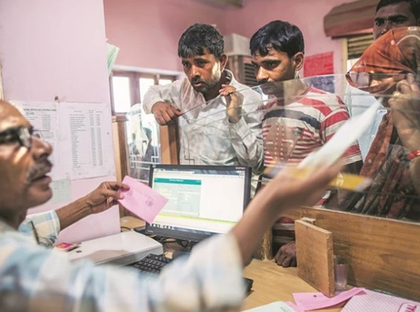Bank body data shows pathetic state of institutional financial inclusion in West Bengal
By IANS | Updated: July 30, 2025 14:54 IST2025-07-30T14:47:57+5:302025-07-30T14:54:48+5:30
Kolkata, July 30 The latest report by a credible bankers' body, on Wednesday, identified the pathetic state of ...

Bank body data shows pathetic state of institutional financial inclusion in West Bengal
Kolkata, July 30 The latest report by a credible bankers' body, on Wednesday, identified the pathetic state of institutional financial inclusion among people residing in rural West Bengal.
The poor show is in terms of both deposits mobilised and loans disbursed by the rural branches operating from the rural belts in the state.
The pathetic picture on this count was revealed in the latest report of the State Level Bankers' Committee (SLBC) in West Bengal having representations from both the different banks operating in the state as well as from the West Bengal government.
As per the report, while the average savings deposit rate per individual per month in rural West Bengal currently stands at just Rs 279, the loan rate per person there is just Rs 19.
Economists say that while the low average savings deposit rate per individual per month indicates the lack of adequate disposable income among the people in rural West Bengal to park in savings, the low rate of loans per person indicates their lack of financial credibility to avail of institutional borrowing.
At the same time, economists say, the two figures also indicate the pathetic credit to deposit (CD) ratio in the state, a factor where West Bengal had been traditionally much behind the national average.
The CD ratio for any state is determined on the basis of the total deposit accumulation figure in the state being divided by the total loans disbursed figure during a particular financial year.
Economists say that the low disposable income affecting regular and reasonable savings is an indication of the lack of adequate employment or income-generation avenues in rural West Bengal and is also an indication of the predominant and over-excessive dependence on farming, which is no longer profitable considering the extremely fragmented land-holding nature in the state.
At the same time, economists say, the self-help group (SHGs) model, which provides avenues for alternative incomes in rural India other than farming, also seems to be lacking successful implementation in rural West Bengal.
SHGs not only provide adequate disposable income to people associated with them to park in savings, but also push up the CD ratio, considering that the SHG sector is a major component in institutional loans.
Finally, economists say, the long stagnant rate of wages in the unorganised sector in rural West Bengal is yet another factor adversely affecting the institutional financial inclusion there.
Disclaimer: This post has been auto-published from an agency feed without any modifications to the text and has not been reviewed by an editor
Open in app